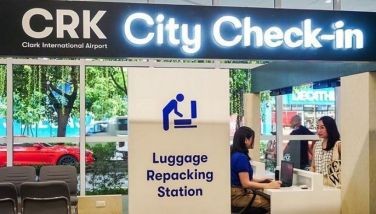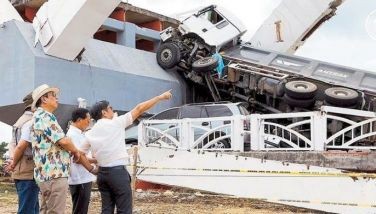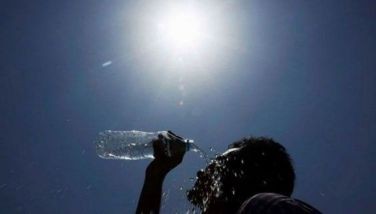Philippines, Japan eye forming security triad with US
TOKYO – The Philippines and Japan have agreed to strengthen military and security ties as well as disaster response cooperation, including holding joint military exercises, with an eye to forming a security triad with the United States.
The agreement came as the two nations confront China’s growing assertiveness in the region particularly in the South China Sea where Beijing has built island fortresses and harassed non-Chinese vessels.
The two nations’ security commitment emerged after a meeting between President Marcos and Japanese Prime Minister Fumio Kishida yesterday. The agreement is also expected to speed up military deployments for humanitarian assistance and disaster relief.
They also signed several other deals, ranging from infrastructure loans to cooperation on agriculture and technology.
“After our meeting, I can confidently say that our strategic partnership is stronger than ever, as we navigate together the rough waters buffeting our region,” Marcos said following talks with Prime Minister Kishida.
Japan is “one of the Philippines’ closest neighbors and closest friends,” Marcos later told reporters.
His trip comes a week after Manila announced a deal giving US troops access to another four military facilities in the Philippines.
Tokyo and Manila are also in preliminary discussions over a key defense pact that would allow them to deploy troops on each others’ territory
for training and other operations.
Japan, which invaded and occupied the Philippines during World War II, has recently inked similar deals with Britain and Australia.
But for now, the leaders are taking an incremental approach to defense cooperation, probably to avoid provoking Beijing, said Renato de Castro, professor in the International Studies department at De La Salle University.
“Both countries are still very much aware that they have touched a sensitive nerve in China (by) creating the possibility of an Asian encirclement of China,” De Castro said.
In Beijing’s view, “this might be the beginning of an Asian NATO. Because you really have Asian countries strengthening and enhancing their security partnerships.”
Worried about Beijing’s growing assertiveness on Taiwan and bases in the disputed South China Sea, Manila has been repairing ties with Washington that were fractured in recent years.
Given its proximity to Taiwan and surrounding waters, cooperation from the Philippines would be key in the event of a conflict with China.
Japan last year announced a major defense overhaul, pledging to double defense spending to the NATO standard of two percent of GDP by 2027 and designating China the “greatest strategic challenge ever” to its security.
US role
Kishida indicated that both countries are looking at including the US in the security cooperation and joint activities. The US has separate security treaties with the Philippines and Japan.
“We will also look into ways to promote our defense equipment and technology cooperation and to strengthen cooperation amongst the Japan, the United States, and the Philippines,” Kishida said.
He said Marcos’ visit gave Japan a renewed momentum for the two nations to further upgrade bilateral partnerships for them make further contributions to the peace and stability of the region and the world.
“With regards to our security cooperation, I explained to the President such matters as Japan’s national security strategy and the President welcomed Japan’s commitment to the free and open international order based on rules,” he said.
Japan is also the Philippines’ biggest diplomatic source of active development assistance, according to Manila, and its second-largest trading partner.
It is the only country to have a bilateral free trade agreement with the Philippines.
On Thursday, the countries also agreed loan agreements and extensions for Philippine infrastructure projects, including $3 billion to finance major commuter rail projects.
TOR on disaster response
Through its Department of National Defense, the Philippines presented the terms of reference (TOR) for humanitarian assistance and disaster relief (HADR) activities with Japan, on the sidelines of President Marcos’ state visit.
“The said TOR facilitates the conduct of HADR activities between the Armed Forces of the Philippines and (Japan Self-Defense Forces), where both armed forces could learn and exchange best practices on search, retrieval and rescue operations, and disaster response on the aftermath of natural and manmade disasters,” the DND said in statement.
Both the Philippines and Japan are prone to natural disasters like earthquake and volcano eruptions, being situated in the so-called Pacific Ring of Fire.
In a separate statement, the National Disaster Risk Reduction and Management Council (NDRRMC) said its executive director Ariel Nepomuceno and Defense Secretary Carlito Galvez Jr. met with the Japanese Disaster Management Minister Tani Koichi for a dialogue on resilience building yesterday.
The conduct of capacity building activities on flood control and, in the light of the recent earthquake disaster in Turkey, collapsed structure search and rescue operations were also discussed in the dialogue, the NDRRMC said.
“Japan has been a long-time partner of the Philippines in the effort to strengthen our disaster management system through various capacity building activities. Through our continued cooperation, we can build resilience not just in our countries but in the ASEAN region as well,” Galvez said.
“This sharing of best practices facilitated by Minister Tani and his team is a very welcome activity on the sidelines of the President’s state visit. We appreciate the Japanese government’s continued support to the Philippine effort to build national resilience,” Nepomuceno said.
600 billion yen aid
The Japanese government committed to provide some 600 billion yen or about P249.7 billion to the Philippines to support the Marcos administration’s goal to attain the upper middle-income economy by 2025.
At a joint conference with Marcos after their meeting, Kishida announced his government’s support of 600 yen or roughly P249.7 billion package for the Philippines.
“The economic development of the Philippines will be a big economic opportunity for both of our countries to support the Economic Development Plan of the Philippines to become an upper-middle-income country,” Kishida said.
Kishida said the assistance would be provided to the Philippines over two years through March 2024 from Japan’s public and private sectors.
The Philippine Development Plan (PDP) 2023-2028, which is the Marcos administration’s strategy for growth and development in the next six years, aims to elevate the country to upper-middle income status by 2025 and reduce poverty incidence to single digit by 2028.
Marcos arrived in Japan on Wednesday for a five-day official visit upon the invitation of Kishida.
The two leaders also witnessed yesterday the signing of seven new bilateral agreements on a range of areas, including infrastructure, security and agriculture.
The Philippines and Japan signed a memorandum of cooperation in the field of information and communications technology and agriculture cooperation.
Marcos said the signing of the memorandum of cooperation on agriculture cooperation is aligned with his priority to harness the agricultural sector and to ensure food security. The President concurrently heads the Department of Agriculture.
Agriculture assistance
Kishida said Japan’s support for the Philippines would “advance efforts in agriculture and ICT by utilizing state-of-the-art technology.”
The two countries also signed diplomatic notes and loan agreements on the North-South Commuter Railway Project and Extension, which Marcos said highlights the value that two nations place in connectivity and improving transportation services.
“It is also a testament to Japan’s contribution in uplifting the daily lives of ordinary Filipinos by sharing Japanese technology and expertise in infrastructure and connectivity,” the President said.
Kishida said he and Marcos welcomed the signing of the TOR concerning the humanitarian assistance and disaster relief activities of Japan’s Self-defense Forces and agreed to continue exploring a framework to strengthen and facilitate such activities as joint exercises.
Marcos described his meeting with Kishida as “deeply engaging,” which he said covered the full range of Philippines-Japan bilateral relations. This was their second face-to-face meeting following their meeting on the sidelines of the United Nations general assembly in September last year.
Marcos said the future of Philippine-Japan relations “remains full of promise” as they continue to deepen and expand engagements across a wide range of mutually beneficial cooperation. - Ralph Edwin Villanueva
- Latest
- Trending




























